Tag Archives: pacific

PACIFIC WATER 10X54 WHOLE HOUSE CARBON IN/OUT VALVE 1.5 CF w. SEDIMENT FILTER
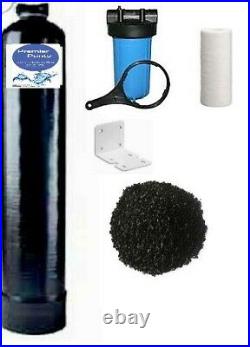

Whole House Water Filter System GAC Carbon (IN & OUT) No Electricity Required. In/Out tank-style water filters works great. Inexpensive, easy to set up, and easy to maintain. They use no electricity and need no drain connection. Since there’s nothing to wear out. They’re virtually trouble free. They use exactly the same granular filter media regular. Granular activated carbon that are used in our more expensive whole house back washing. The main requirement for use of these whole house non-back washing tank-style filters is. If the objective is to remove chlorine from clean city water, a non-back washing. In/Out filter does an exceptional job. Unless the inlet water is very clean and free of rust and. Other sediment, we recommend that a cartridge-style sediment filter be installed in front of. The In/Out whole house carbon filters are efficient devices. They cost considerably less than. Their back washing counterparts and require less maintenance. They save water no back. Washing and they do not require electricity. With In/Out units, water simply enters the tank, passes through the media bed, and flows. There is no cleaning process. Non-back washing tank filters are arranged so that the. Water being treated flows upward through the tank, entering at the bottom and exiting at the. This reversed flow lifts the bed, keeps it fresh, and minimizes channeling. The filters listed below are equipped with In/Out head. Estimated re-bed interval is every. Three years or so, depending on usage and chlorine content of your water. A whole-house filter system treats all water traveling to any faucet or fixture in the home. It removes the chemical before it can be ingested, breathed in, or absorbed by the skin during washing or bathing. This unit comes with. 1.5 – CU FT OF GRANULAR ACTIVATED CARBON. Carbon is a substance that has a long history of being used to absorb impurities and is perhaps the most powerful absorbent known to man. One pound of carbon contains a surface area of roughly 125 acres and can absorb literally thousands of different chemicals. Activated carbon which has a slight electro-positive charge added to it, making it even more attractive to chemicals and impurities. As the water passes over the positively charged carbon surface, the negative ions of the of the contaminants are drawn to the surface of the carbon granules. Activated carbon filters used for home water treatment typically contain either granular activated carbon or powdered block carbon. Although both are effective, carbon block filters generally have a higher contaminant removal ratio. The two most important factors affecting the efficiency of activated carbon filtration are the amount of carbon in the unit and the amount of time the contaminant spends in contact with it. The more carbon the better. Similarly, the lower the flow rate of the water, the more time contaminants will be in contact with the carbon, and the more absorption that will take place. Particle size also affects removal rates. The most common carbon types used in water filtration are bituminous, wood, and coconut shell carbons. While coconut shell carbon typically costs 20% more than the others, it is generally regarded as the most effective of the three. All of our activated carbon filters use coconut shell carbon. There are two principal mechanisms by which activated carbon removes contaminants from water; absorption, and catalytic reduction, a process involving the attraction of negatively-charged contaminants ions to the positively-charged activated carbon. Organic compounds are removed by absorption and residual disinfectants such as chlorine and chloramines are removed by catalytic reduction. Activated carbon filtration is very common in a number of home water treatment systems. It can be used as a stand alone filter to reduce or eliminate bad tastes and odors, chlorine, and many organic contaminants in municipal (pre-treated or chlorinated) water supplies to produce a significantly improved drinking water. Activated Carbon GAC remove/reduce many volatile organic chemicals (VOC’s), pesticides and herbicides, as well as chlorine, benzene, trihalomethane (THM’s) compounds, radon, solvents and hundreds of other man-made chemicals found in tap water. Whole House Water Filtration. This unit includes the following. 10″D x 54″H Mineral Tank (Color Varies). In & Out Valve. (Design Varies) 1pipe connection. 1.5 CU FT GAC Coconut Shell Carbon. Good Economical Whole House GAC Carbon Water Filter System. The Sediment Filter installed before the Carbon filter, prolongs the life of the filter by removing sediment that can clog the carbon media, and clarifies the water entering your home. All of our sediment filters use multi-gradient spun polypropylene filter cartridges. These cartridges use the entire depth of their media by trapping the largest sediment particles on the outside of the filter, then gradually stepping down the size of particles they will reject as the water moves closer to the core of the filter. The result is longer filter life, greater dirt-holding capacity, higher flow rates, and remarkably low pressure drop. The 100% pure polypropylene media is highly resistant to bacteria and chemicals, making this an excellent choice for both well water and municipal water treatment applications. 4.5X10 SEDIMENT FILTER. 4 MOUNTING SCREWS FOR BRACKET TO HOUSINGS. No manual is provided. The item “PACIFIC WATER 10X54 WHOLE HOUSE CARBON IN/OUT VALVE 1.5 CF w. SEDIMENT FILTER” is in sale since Monday, June 23, 2014. This item is in the category “Home & Garden\Home Improvement\Plumbing & Fixtures\Pumps & Water Filtration Systems\Water Filters & Filtration Parts”. The seller is “pacificwatersystems” and is located in Lancaster, California. This item can be shipped to United States.
- Compatible Brand: Titan
- Type: Carbon Filters
- Compatible Model: Titan
- MPN: TWP1054
- Contaminant Removal: Chlorine Taste & Odor
- Replacement Filter Type: Whole House Filter
- Brand: Titan


Pacific Water 9×48 Whole House Catalytic Carbon Filter In/out Valve 1 Cu Ft
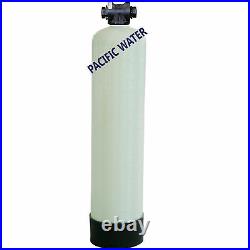

WHOLE HOUSE WATER FILTER. Whole-House Filters or Point of Entry: A whole-house filter is installed at a point on the homes water supply plumbing that will result in treatment of all water that travels to any faucet or fixture in the home. A whole-house filter system treats all water traveling to any faucet or fixture in the home. It removes the chemical before it can be ingested, breathed in, or absorbed by the skin during washing or bathing. 1 CU FT OF GRANULAR CATALYTIC ACTIVATED CARBON. EXCELLENT FOR HYDROGEN SULFIDE AND CHLORAMINES. Carbon is a substance that has a long history of being used to absorb impurities and is perhaps the most powerful absorbent known to man. One pound of carbon contains a surface area of roughly 125 acres and can absorb literally thousands of different chemicals. Activated carbon which has a slight electro-positive charge added to it, making it even more attractive to chemicals and impurities. As the water passes over the positively charged carbon surface, the negative ions of the of the contaminants are drawn to the surface of the carbon granules. Activated carbon filters used for home water treatment typically contain either granular activated carbon or powdered block carbon. Although both are effective, carbon block filters generally have a higher contaminant removal ratio. The two most important factors affecting the efficiency of activated carbon filtration are the amount of carbon in the unit and the amount of time the contaminant spends in contact with it. The more carbon the better. Similarly, the lower the flow rate of the water, the more time contaminants will be in contact with the carbon, and the more absorption that will take place. Particle size also affects removal rates. The most common carbon types used in water filtration are bituminous, wood, and coconut shell carbons. While coconut shell carbon typically costs 20% more than the others, it is generally regarded as the most effective of the three. All of our activated carbon filters use coconut shell carbon. There are two principal mechanisms by which activated carbon removes contaminants from water; absorption, and catalytic reduction, a process involving the attraction of negatively-charged contaminants ions to the positively-charged activated carbon. Organic compounds are removed by absorption and residual disinfectants such as chlorine and chloramines are removed by catalytic reduction. Activated carbon filtration is very common in a number of home water treatment systems. It can be used as a stand alone filter to reduce or eliminate bad tastes and odors, chlorine, and many organic contaminants in municipal (pre-treated or chlorinated) water supplies to produce a significantly improved drinking water. It is also very commonly used as a pre-treatment as part of a reverse osmosis system to reduce many organic contaminants, chlorine, and other items that could foul the reverse osmosis membrane. 0.5 block filters are commonly used to remove systs such as giardia and crytosporidium. Activated carbon filters remove/reduce many volatile organic chemicals (VOC), pesticides and herbicides, as well as chlorine, benzene, trihalomethane (THM) compounds, radon, solvents and hundreds of other man-made chemicals found in tap water. Whole House Water Filtration. This unit includes the following. 9X48 Mineral Tank (Almond, Black or Blue). Good Economical Whole House GAC Carbon Water Filter System. The item “PACIFIC WATER 9X48 WHOLE HOUSE CATALYTIC CARBON FILTER IN/OUT VALVE 1 CU FT” is in sale since Sunday, June 22, 2014. This item is in the category “Home & Garden\Home Improvement\Plumbing & Fixtures\Pumps & Water Filtration Systems\Water Filters & Filtration Parts”. The seller is “pacificwatersystems” and is located in Lancaster, California. This item can be shipped to United States, United Kingdom, Denmark, Romania, Slovakia, Bulgaria, Czech republic, Finland, Hungary, Latvia, Lithuania, Malta, Estonia, Australia, Greece, Portugal, Cyprus, Slovenia, Japan, China, Sweden, South Korea, Indonesia, Taiwan, Thailand, Belgium, France, Hong Kong, Ireland, Netherlands, Poland, Spain, Italy, Germany, Austria, Bahamas, Israel, Mexico, New Zealand, Philippines, Singapore, Switzerland, Norway, Saudi arabia, United arab emirates, Qatar, Kuwait, Bahrain, Croatia, Malaysia, Chile, Costa rica, Panama, Trinidad and tobago, Guatemala, Honduras, Jamaica, Aruba, Belize, Dominica, Grenada, Saint kitts and nevis, Turks and caicos islands, Bangladesh, Brunei darussalam, Bolivia, Ecuador, Egypt, French guiana, Guernsey, Gibraltar, Guadeloupe, Iceland, Jersey, Jordan, Cambodia, Liechtenstein, Luxembourg, Monaco, Macao, Martinique, Nicaragua, Peru, Pakistan, Paraguay, Viet nam, Uruguay, Canada, South africa, Colombia, Antigua and barbuda, Saint lucia, Barbados, Bermuda, Cayman islands, Sri lanka, Maldives, Oman, Reunion, Montserrat, Ukraine.


Pacific Water 9×48 Whole House Catalytic Carbon Filter 1 Cu Ft Manual Valve
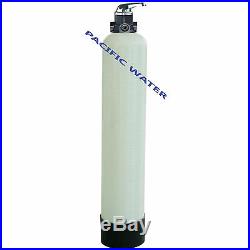

WHOLE HOUSE WATER FILTER. Whole-House Filters or Point of Entry: A whole-house filter is installed at a point on the homes water supply plumbing that will result in treatment of all water that travels to any faucet or fixture in the home. A whole-house filter system treats all water traveling to any faucet or fixture in the home. It removes the chemical before it can be ingested, breathed in, or absorbed by the skin during washing or bathing. Backwash on demand (manual). 1 CU FT OF CATALYTIC GRANULAR ACTIVATED CARBON. BETTER MORE FORTIFIED CARBON FOR LOW HYDROGEN SULFIDE CHLORAMINE REMOVAL. Carbon is a substance that has a long history of being used to absorb impurities and is perhaps the most powerful absorbent known to man. One pound of carbon contains a surface area of roughly 125 acres and can absorb literally thousands of different chemicals. Activated carbon which has a slight electro-positive charge added to it, making it even more attractive to chemicals and impurities. As the water passes over the positively charged carbon surface, the negative ions of the of the contaminants are drawn to the surface of the carbon granules. Activated carbon filters used for home water treatment typically contain either granular activated carbon or powdered block carbon. Although both are effective, carbon block filters generally have a higher contaminant removal ratio. The two most important factors affecting the efficiency of activated carbon filtration are the amount of carbon in the unit and the amount of time the contaminant spends in contact with it. The more carbon the better. Similarly, the lower the flow rate of the water, the more time contaminants will be in contact with the carbon, and the more absorption that will take place. Particle size also affects removal rates. The most common carbon types used in water filtration are bituminous, wood, and coconut shell carbons. While coconut shell carbon typically costs 20% more than the others, it is generally regarded as the most effective of the three. All of our activated carbon filters use coconut shell carbon. There are two principal mechanisms by which activated carbon removes contaminants from water; absorption, and catalytic reduction, a process involving the attraction of negatively-charged contaminants ions to the positively-charged activated carbon. Organic compounds are removed by absorption and residual disinfectants such as chlorine and chloramines are removed by catalytic reduction. Activated carbon filtration is very common in a number of home water treatment systems. It can be used as a stand alone filter to reduce or eliminate bad tastes and odors, chlorine, and many organic contaminants in municipal (pre-treated or chlorinated) water supplies to produce a significantly improved drinking water. It is also very commonly used as a pre-treatment as part of a reverse osmosis system to reduce many organic contaminants, chlorine, and other items that could foul the reverse osmosis membrane. 0.5 block filters are commonly used to remove systs such as giardia and crytosporidium. Activated carbon filters remove/reduce many volatile organic chemicals (VOC), pesticides and herbicides, as well as chlorine, benzene, trihalomethane (THM) compounds, radon, solvents and hundreds of other man-made chemicals found in tap water. Whole House Water Filtration. This unit includes the following. 9X48 Mineral Tank (Almond, Black or Blue). Good Economical Whole House GAC Carbon Water Filter System. His is the Manual valve. It has very few moving parts, and easy to use. When you need to backwash a filter, you put it into the backwash cycle for 10 minutes, followed by a rinse for 3 minutes, and then back into the service mode. That is all there is to it! Once a week schedule for backwashing is generally sufficient. For a more economical product, and ease of use, we recommend you get this rather than opting for a unit that does not backwash, read the section on the benefits of backwashing. Benefits and Importance of a Backwash Cycle. As the filter operates in service mode, it collects particles in the filter bed. Also, since water’s nature is to follow the path of least resistance, after a time it begins to cut channels through the medium. As channels or holes in the media bed form, water begins to flow around rather than through the medium. This process is called “channeling” and it reduces the effectiveness of the filter considerably. The backwash is accomplished by sending the water down the riser tube from wich it enters the filter tank at the bottom. The force of the water is such that it actually lifts the media bed, swirling and tossing the granular medium. The water leaves the filter tank through the control valve, wich routes it through the filter’s drain line. Particles that were in the bed are washed to drain. The backwash is an intense rinsing and tossing of the medium that lasts for several minutes. In a standard residential filter, a typical backwash lasts about ten minutes. After the backwash, initiate a “rinse” of the bed during which water flows downward through the medium, up through the distribution tube and out the drain. The purpose of this rinse is to rinse and settle the bed and prepare it for return to service flow. A regular backwash schedule maintains the efficiency of the filter, as well as providing cleaner water. The item “PACIFIC WATER 9X48 WHOLE HOUSE CATALYTIC CARBON FILTER 1 CU FT MANUAL VALVE” is in sale since Sunday, June 22, 2014. This item is in the category “Home & Garden\Home Improvement\Plumbing & Fixtures\Water Filters”. The seller is “pacificwatersystems” and is located in Lancaster, California. This item can be shipped to United States, Canada, United Kingdom, Denmark, Romania, Slovakia, Bulgaria, Czech republic, Finland, Hungary, Latvia, Lithuania, Malta, Estonia, Australia, Greece, Portugal, Cyprus, Slovenia, Japan, China, Sweden, South Korea, Indonesia, Taiwan, South africa, Thailand, Belgium, France, Hong Kong, Ireland, Netherlands, Poland, Spain, Italy, Germany, Austria, Bahamas, Israel, Mexico, New Zealand, Philippines, Singapore, Switzerland, Norway, Saudi arabia, Ukraine, United arab emirates, Qatar, Kuwait, Bahrain, Croatia, Malaysia, Brazil, Chile, Colombia, Costa rica, Panama, Trinidad and tobago, Guatemala, Honduras, Jamaica, Viet nam, Uruguay, Antigua and barbuda, Aruba, Belize, Dominica, Saint lucia, Barbados, Brunei darussalam, Bolivia, Ecuador, Guadeloupe, Jordan, Cambodia, Sri lanka, Luxembourg, Macao, Maldives, Nicaragua, Peru, Paraguay.

Pacific Water 9×48 Whole House Carbon Filter 1 Cu Ft Media Manual Valve
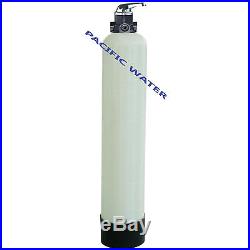

WHOLE HOUSE WATER FILTER. Whole-House Filters or Point of Entry: A whole-house filter is installed at a point on the homes water supply plumbing that will result in treatment of all water that travels to any faucet or fixture in the home. A whole-house filter system treats all water traveling to any faucet or fixture in the home. It removes the chemical before it can be ingested, breathed in, or absorbed by the skin during washing or bathing. Backwash on demand (manual). 1 CU FT OF GRANULAR ACTIVATED CARBON. Carbon is a substance that has a long history of being used to absorb impurities and is perhaps the most powerful absorbent known to man. One pound of carbon contains a surface area of roughly 125 acres and can absorb literally thousands of different chemicals. Activated carbon which has a slight electro-positive charge added to it, making it even more attractive to chemicals and impurities. As the water passes over the positively charged carbon surface, the negative ions of the of the contaminants are drawn to the surface of the carbon granules. Activated carbon filters used for home water treatment typically contain either granular activated carbon or powdered block carbon. Although both are effective, carbon block filters generally have a higher contaminant removal ratio. The two most important factors affecting the efficiency of activated carbon filtration are the amount of carbon in the unit and the amount of time the contaminant spends in contact with it. The more carbon the better. Similarly, the lower the flow rate of the water, the more time contaminants will be in contact with the carbon, and the more absorption that will take place. Particle size also affects removal rates. The most common carbon types used in water filtration are bituminous, wood, and coconut shell carbons. While coconut shell carbon typically costs 20% more than the others, it is generally regarded as the most effective of the three. All of our activated carbon filters use coconut shell carbon. There are two principal mechanisms by which activated carbon removes contaminants from water; absorption, and catalytic reduction, a process involving the attraction of negatively-charged contaminants ions to the positively-charged activated carbon. Organic compounds are removed by absorption and residual disinfectants such as chlorine and chloramines are removed by catalytic reduction. Activated carbon filtration is very common in a number of home water treatment systems. It can be used as a stand alone filter to reduce or eliminate bad tastes and odors, chlorine, and many organic contaminants in municipal (pre-treated or chlorinated) water supplies to produce a significantly improved drinking water. It is also very commonly used as a pre-treatment as part of a reverse osmosis system to reduce many organic contaminants, chlorine, and other items that could foul the reverse osmosis membrane. 0.5 block filters are commonly used to remove systs such as giardia and crytosporidium. Activated carbon filters remove/reduce many volatile organic chemicals (VOC), pesticides and herbicides, as well as chlorine, benzene, trihalomethane (THM) compounds, radon, solvents and hundreds of other man-made chemicals found in tap water. Whole House Water Filtration. This unit includes the following. 9X48 Mineral Tank (Almond, Black or Blue). Good Economical Whole House GAC Carbon Water Filter System. His is the Manual valve. It has very few moving parts, and easy to use. When you need to backwash a filter, you put it into the backwash cycle for 10 minutes, followed by a rinse for 3 minutes, and then back into the service mode. That is all there is to it! Once a week schedule for backwashing is generally sufficient. For a more economical product, and ease of use, we recommend you get this rather than opting for a unit that does not backwash, read the section on the benefits of backwashing. Benefits and Importance of a Backwash Cycle. As the filter operates in service mode, it collects particles in the filter bed. Also, since water’s nature is to follow the path of least resistance, after a time it begins to cut channels through the medium. As channels or holes in the media bed form, water begins to flow around rather than through the medium. This process is called “channeling” and it reduces the effectiveness of the filter considerably. The backwash is accomplished by sending the water down the riser tube from wich it enters the filter tank at the bottom. The force of the water is such that it actually lifts the media bed, swirling and tossing the granular medium. The water leaves the filter tank through the control valve, wich routes it through the filter’s drain line. Particles that were in the bed are washed to drain. The backwash is an intense rinsing and tossing of the medium that lasts for several minutes. In a standard residential filter, a typical backwash lasts about ten minutes. After the backwash, initiate a “rinse” of the bed during which water flows downward through the medium, up through the distribution tube and out the drain. The purpose of this rinse is to rinse and settle the bed and prepare it for return to service flow. A regular backwash schedule maintains the efficiency of the filter, as well as providing cleaner water. The item “PACIFIC WATER 9X48 WHOLE HOUSE CARBON FILTER 1 CU FT MEDIA MANUAL VALVE” is in sale since Sunday, June 22, 2014. This item is in the category “Home & Garden\Home Improvement\Plumbing & Fixtures\Water Filters”. The seller is “pacificwatersystems” and is located in Canyon Country, California. This item can be shipped to United States, Canada, United Kingdom, Denmark, Romania, Slovakia, Bulgaria, Czech republic, Finland, Hungary, Latvia, Lithuania, Malta, Estonia, Australia, Greece, Portugal, Cyprus, Slovenia, Japan, China, Sweden, South Korea, Indonesia, Taiwan, South africa, Thailand, Belgium, France, Hong Kong, Ireland, Netherlands, Poland, Spain, Italy, Germany, Austria, Israel, Mexico, New Zealand, Philippines, Singapore, Switzerland, Norway, Saudi arabia, Ukraine, United arab emirates, Qatar, Kuwait, Bahrain, Croatia, Malaysia, Brazil, Chile, Colombia, Costa rica, Panama, Trinidad and tobago, Guatemala, Honduras, Jamaica.

PACIFIC WATER 10×54 WHOLE HOUSE CARBON FILTER IN/OUT VALVE 1.5 CU FT MEDIA
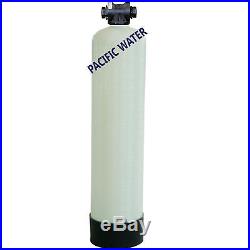

WHOLE HOUSE WATER FILTER. Whole-House Filters or Point of Entry. A whole-house filter is installed at a point on the homes water supply plumbing that will result in treatment of all water that travels to any faucet or fixture in the home. A whole-house filter system treats all water traveling to any faucet or fixture in the home. It removes the chemical before it can be ingested, breathed in, or absorbed by the skin during washing or bathing. 1.5 CU FT OF GRANULAR ACTIVATED CARBON. Carbon is a substance that has a long history of being used to absorb impurities and is perhaps the most powerful absorbent known to man. One pound of carbon contains a surface area of roughly 125 acres and can absorb literally thousands of different chemicals. Activated carbon which has a slight electro-positive charge added to it, making it even more attractive to chemicals and impurities. As the water passes over the positively charged carbon surface, the negative ions of the of the contaminants are drawn to the surface of the carbon granules. Activated carbon filters used for home water treatment typically contain either granular activated carbon or powdered block carbon. Although both are effective, carbon block filters generally have a higher contaminant removal ratio. The two most important factors affecting the efficiency of activated carbon filtration are the amount of carbon in the unit and the amount of time the contaminant spends in contact with it. The more carbon the better. Similarly, the lower the flow rate of the water, the more time contaminants will be in contact with the carbon, and the more absorption that will take place. Particle size also affects removal rates. The most common carbon types used in water filtration are bituminous, wood, and coconut shell carbons. While coconut shell carbon typically costs 20% more than the others, it is generally regarded as the most effective of the three. All of our activated carbon filters use coconut shell carbon. There are two principal mechanisms by which activated carbon removes contaminants from water; absorption, and catalytic reduction, a process involving the attraction of negatively-charged contaminants ions to the positively-charged activated carbon. Organic compounds are removed by absorption and residual disinfectants such as chlorine and chloramines are removed by catalytic reduction. Activated carbon filtration is very common in a number of home water treatment systems. It can be used as a stand alone filter to reduce or eliminate bad tastes and odors, chlorine, and many organic contaminants in municipal (pre-treated or chlorinated) water supplies to produce a significantly improved drinking water. It is also very commonly used as a pre-treatment as part of a reverse osmosis system to reduce many organic contaminants, chlorine, and other items that could foul the reverse osmosis membrane. 0.5 block filters are commonly used to remove systs such as giardia and crytosporidium. Activated carbon filters remove/reduce many volatile organic chemicals (VOC), pesticides and herbicides, as well as chlorine, benzene, trihalomethane (THM) compounds, radon, solvents and hundreds of other man-made chemicals found in tap water. Whole House Water Filtration. This unit includes the following. 10×54 Mineral Tank (Black or Blue). Good Economical Whole House GAC Carbon Water Filter System. The item “PACIFIC WATER 10×54 WHOLE HOUSE CARBON FILTER IN/OUT VALVE 1.5 CU FT MEDIA” is in sale since Thursday, December 10, 2015. This item is in the category “Home & Garden\Home Improvement\Plumbing & Fixtures\Water Filters”. The seller is “pacificwatersystems” and is located in Canyon Country, California. This item can be shipped to United States, Canada, United Kingdom, Denmark, Romania, Slovakia, Bulgaria, Czech republic, Finland, Hungary, Latvia, Lithuania, Malta, Estonia, Australia, Greece, Portugal, Cyprus, Slovenia, Japan, China, Sweden, South Korea, Indonesia, Taiwan, South africa, Thailand, Belgium, France, Hong Kong, Ireland, Netherlands, Poland, Spain, Italy, Germany, Austria, Israel, Mexico, New Zealand, Philippines, Singapore, Switzerland, Norway, Saudi arabia, Ukraine, United arab emirates, Qatar, Kuwait, Bahrain, Croatia, Malaysia, Brazil, Chile, Colombia, Costa rica, Panama, Trinidad and tobago, Guatemala, Honduras, Jamaica.
- Brand: TWP
- Model: WHIO15
- MPN: WHIO15
- Type: WHOLE HOUSE GAC CARBON FILTER
- Country/Region of Manufacture: United States

PACIFIC WATER 9X48 WHOLE HOUSE CARBON IN/OUT VALVE 1 CU FT w. SEDIMENT FILTER


WHOLE HOUSE WATER FILTER. Whole-House Filters or Point of Entry: A whole-house filter is installed at a point on the homes water supply plumbing that will result in treatment of all water that travels to any faucet or fixture in the home. A whole-house filter system treats all water traveling to any faucet or fixture in the home. It removes the chemical before it can be ingested, breathed in, or absorbed by the skin during washing or bathing. 1 CU FT OF GRANULAR ACTIVATED CARBON. Carbon is a substance that has a long history of being used to absorb impurities and is perhaps the most powerful absorbent known to man. One pound of carbon contains a surface area of roughly 125 acres and can absorb literally thousands of different chemicals. Activated carbon which has a slight electro-positive charge added to it, making it even more attractive to chemicals and impurities. As the water passes over the positively charged carbon surface, the negative ions of the of the contaminants are drawn to the surface of the carbon granules. Activated carbon filters used for home water treatment typically contain either granular activated carbon or powdered block carbon. Although both are effective, carbon block filters generally have a higher contaminant removal ratio. The two most important factors affecting the efficiency of activated carbon filtration are the amount of carbon in the unit and the amount of time the contaminant spends in contact with it. The more carbon the better. Similarly, the lower the flow rate of the water, the more time contaminants will be in contact with the carbon, and the more absorption that will take place. Particle size also affects removal rates. The most common carbon types used in water filtration are bituminous, wood, and coconut shell carbons. While coconut shell carbon typically costs 20% more than the others, it is generally regarded as the most effective of the three. All of our activated carbon filters use coconut shell carbon. There are two principal mechanisms by which activated carbon removes contaminants from water; absorption, and catalytic reduction, a process involving the attraction of negatively-charged contaminants ions to the positively-charged activated carbon. Organic compounds are removed by absorption and residual disinfectants such as chlorine and chloramines are removed by catalytic reduction. Activated carbon filtration is very common in a number of home water treatment systems. It can be used as a stand alone filter to reduce or eliminate bad tastes and odors, chlorine, and many organic contaminants in municipal (pre-treated or chlorinated) water supplies to produce a significantly improved drinking water. It is also very commonly used as a pre-treatment as part of a reverse osmosis system to reduce many organic contaminants, chlorine, and other items that could foul the reverse osmosis membrane. 0.5 block filters are commonly used to remove systs such as giardia and crytosporidium. Activated carbon filters remove/reduce many volatile organic chemicals (VOC), pesticides and herbicides, as well as chlorine, benzene, trihalomethane (THM) compounds, radon, solvents and hundreds of other man-made chemicals found in tap water. Whole House Water Filtration. This unit includes the following. 9X48 Mineral Tank (Almond, Black or Blue). Good Economical Whole House GAC Carbon Water Filter System. The Sediment Filter installed before the Carbon filter, prolongs the life of the filter by removing sediment that can clog the carbon media, and clarifies the water entering your home. All of our sediment filters use multi-gradient spun polypropylene filter cartridges. These cartridges use the entire depth of their media by trapping the largest sediment particles on the outside of the filter, then gradually stepping down the size of particles they will reject as the water moves closer to the core of the filter. The result is longer filter life, greater dirt-holding capacity, higher flow rates, and remarkably low pressure drop. The 100% pure polypropylene media is highly resistant to bacteria and chemicals, making this an excellent choice for both well water and municipal water treatment applications. 4.5X10 SEDIMENT FILTER. The item “PACIFIC WATER 9X48 WHOLE HOUSE CARBON IN/OUT VALVE 1 CU FT w. SEDIMENT FILTER” is in sale since Monday, June 23, 2014. This item is in the category “Home & Garden\Home Improvement\Plumbing & Fixtures\Water Filters”. The seller is “pacificwatersystems” and is located in Canyon Country, California. This item can be shipped to United States, Canada, United Kingdom, Denmark, Romania, Slovakia, Bulgaria, Czech republic, Finland, Hungary, Latvia, Lithuania, Malta, Estonia, Australia, Greece, Portugal, Cyprus, Slovenia, Japan, China, Sweden, South Korea, Indonesia, Taiwan, South africa, Thailand, Belgium, France, Hong Kong, Ireland, Netherlands, Poland, Spain, Italy, Germany, Austria, Israel, Mexico, New Zealand, Philippines, Singapore, Switzerland, Norway, Saudi arabia, Ukraine, United arab emirates, Qatar, Kuwait, Bahrain, Croatia, Malaysia, Brazil, Chile, Colombia, Costa rica, Panama, Trinidad and tobago, Guatemala, Honduras, Jamaica.

PACIFIC WATER 10×54 WHOLE HOUSE CATALYTIC CARBON FILTER IN/OUT VALVE 1.5 cu ft
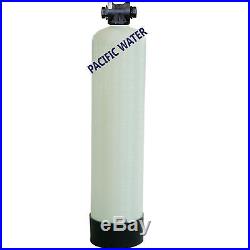

WHOLE HOUSE WATER FILTER. Whole-House Filters or Point of Entry: A whole-house filter is installed at a point on the homes water supply plumbing that will result in treatment of all water that travels to any faucet or fixture in the home. A whole-house filter system treats all water traveling to any faucet or fixture in the home. It removes the chemical before it can be ingested, breathed in, or absorbed by the skin during washing or bathing. 1.5 CU FT OF GRANULAR CATALYTIC ACTIVATED CARBON. EXCELLENT FOR HYDROGEN SULFIDE AND CHLORAMINES. Carbon is a substance that has a long history of being used to absorb impurities and is perhaps the most powerful absorbent known to man. One pound of carbon contains a surface area of roughly 125 acres and can absorb literally thousands of different chemicals. Activated carbon which has a slight electro-positive charge added to it, making it even more attractive to chemicals and impurities. As the water passes over the positively charged carbon surface, the negative ions of the of the contaminants are drawn to the surface of the carbon granules. Activated carbon filters used for home water treatment typically contain either granular activated carbon or powdered block carbon. Although both are effective, carbon block filters generally have a higher contaminant removal ratio. The two most important factors affecting the efficiency of activated carbon filtration are the amount of carbon in the unit and the amount of time the contaminant spends in contact with it. The more carbon the better. Similarly, the lower the flow rate of the water, the more time contaminants will be in contact with the carbon, and the more absorption that will take place. Particle size also affects removal rates. The most common carbon types used in water filtration are bituminous, wood, and coconut shell carbons. While coconut shell carbon typically costs 20% more than the others, it is generally regarded as the most effective of the three. All of our activated carbon filters use coconut shell carbon. There are two principal mechanisms by which activated carbon removes contaminants from water; absorption, and catalytic reduction, a process involving the attraction of negatively-charged contaminants ions to the positively-charged activated carbon. Organic compounds are removed by absorption and residual disinfectants such as chlorine and chloramines are removed by catalytic reduction. Activated carbon filtration is very common in a number of home water treatment systems. It can be used as a stand alone filter to reduce or eliminate bad tastes and odors, chlorine, and many organic contaminants in municipal (pre-treated or chlorinated) water supplies to produce a significantly improved drinking water. It is also very commonly used as a pre-treatment as part of a reverse osmosis system to reduce many organic contaminants, chlorine, and other items that could foul the reverse osmosis membrane. 0.5 block filters are commonly used to remove systs such as giardia and cryptosporidium. Activated carbon filters remove/reduce many volatile organic chemicals (VOC), pesticides and herbicides, as well as chlorine, benzene, trihalomethane (THM) compounds, radon, solvents and hundreds of other man-made chemicals found in tap water. Whole House Water Filtration. This unit includes the following. 10×54 Mineral Tank (Almond, Black or Blue). Good Economical Whole House Catalytic Carbon Water Filter System. The item “PACIFIC WATER 10×54 WHOLE HOUSE CATALYTIC CARBON FILTER IN/OUT VALVE 1.5 cu ft” is in sale since Monday, June 23, 2014. This item is in the category “Home & Garden\Home Improvement\Plumbing & Fixtures\Water Filters”. The seller is “pacificwatersystems” and is located in Canyon Country, California. This item can be shipped to United States, Canada, United Kingdom, Denmark, Romania, Slovakia, Bulgaria, Czech republic, Finland, Hungary, Latvia, Lithuania, Malta, Estonia, Australia, Greece, Portugal, Cyprus, Slovenia, Japan, China, Sweden, South Korea, Indonesia, Taiwan, South africa, Thailand, Belgium, France, Hong Kong, Ireland, Netherlands, Poland, Spain, Italy, Germany, Austria, Israel, Mexico, New Zealand, Philippines, Singapore, Switzerland, Norway, Saudi arabia, Ukraine, United arab emirates, Qatar, Kuwait, Bahrain, Croatia, Malaysia, Brazil, Chile, Colombia, Costa rica, Panama, Trinidad and tobago, Guatemala, Honduras, Jamaica.
- Brand: Pacific
- Model: TWP1054CC
- Type: WHOLE HOUSE WATER FILTER
- Country/Region of Manufacture: United States
- whole house water filter: catalytic carbon
- chloramine removal: chlorine removal
